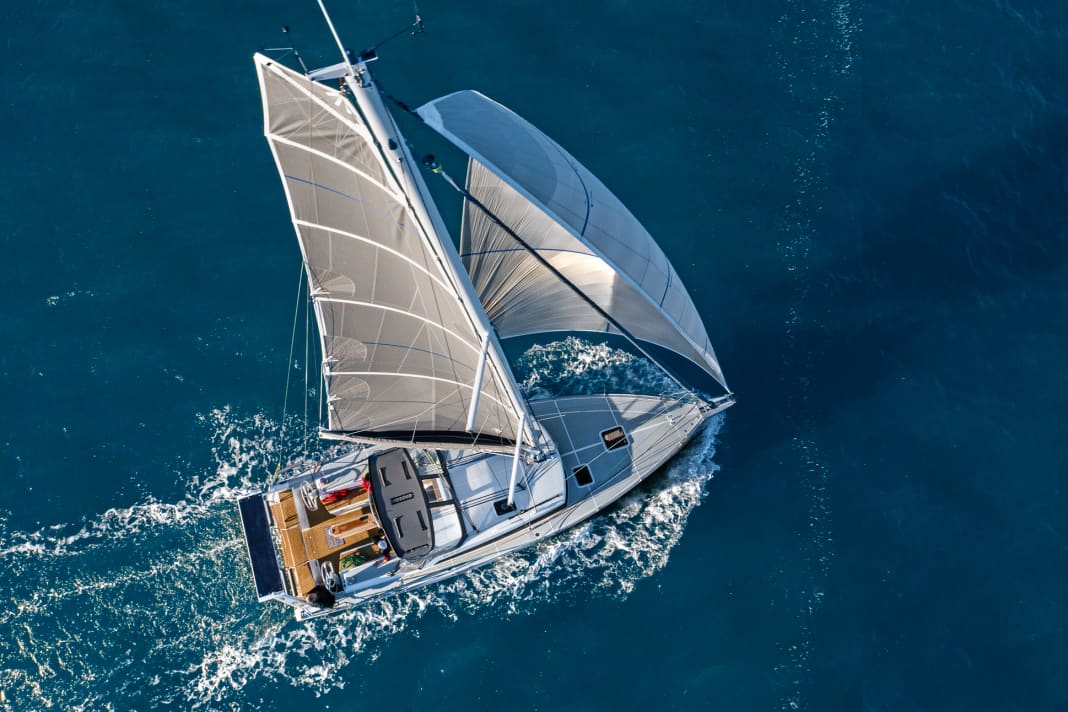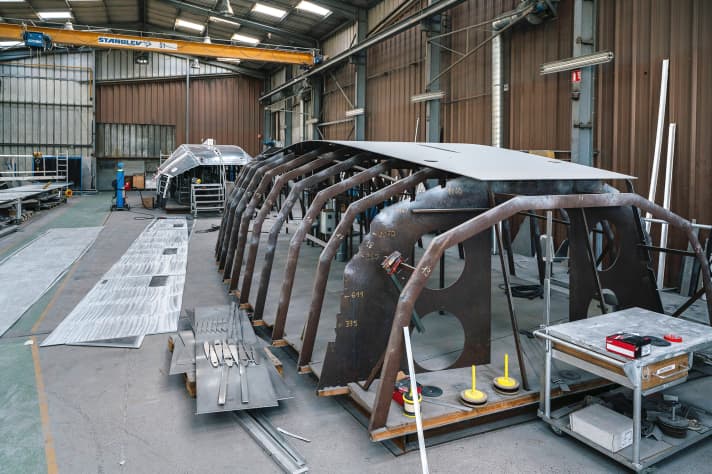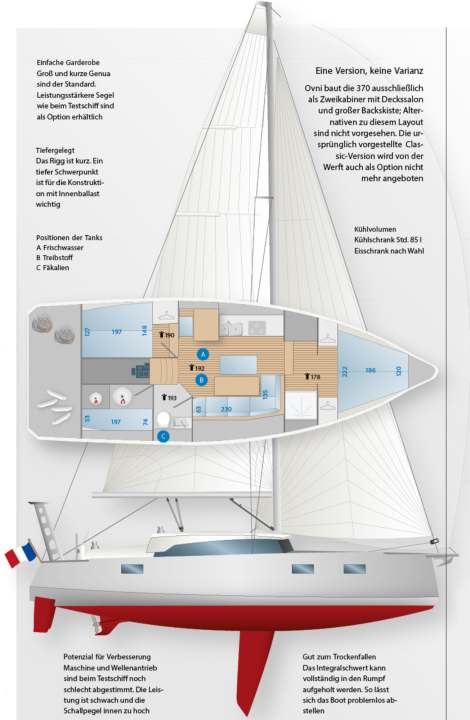





Turbulent times lie behind Alubat in France. On the one hand, the aluminium specialists in Les Sables-d'Olonne are building their first cruising catamaran. The Ovnicat 48 project was put on ice for some time due to a lack of buyers, but is now being realised. At the same time, the shipyard is expanding its upmarket semi-custom Cigale range. A particularly powerful 16-metre vessel is currently being built and a new Cigale 15 is due to go into series production soon.
On top of this, Alubat has also announced another change in management. Luc Jurien is the new man at the helm of the company, a man with a wealth of experience as a blue water sailor. The engineer and his family spent a total of six years sailing the world's oceans on an aluminium yacht from Alubat.
Deck saloon planned as a variant is now standard on the Ovni 370
Irrespective of this, the shipyard is continuing to work hard on expanding its core business, the cruise and blue water programme. With the Ovni 400 (test YACHT 3/2020), Alubat has thrown the brand's long-established design parameters overboard for the time being and surprisingly presented a radically different boat. The visually eye-catching and very polarising design from the collaboration with the designers from Mortain & Mavrikios was presented as a novelty at boot in Düsseldorf 2020 and is now coming to the market. as Ovni 430 in a revised version on the market.
The Ovni 370 followed with a very similar visual appearance. 11.95 metres in length, its hull is only a good 30 centimetres shorter than that of its larger sister, but significantly less wide. The maximum extension is 3.99 metres, which corresponds to an average aspect ratio of 3.0 for cruising yachts.
Despite many visual similarities on the outside, there are major differences between the two latest Ovni models, particularly below deck. The 370 was launched as a true deck saloon yacht, i.e. with multiple stepped living levels and a raised seating area where you can enjoy an unobstructed view to the outside even when seated. On the Ovni 400, on the other hand, the layout remains conventional, with all functional areas on one level. This classic layout was also considered as an extension option for the 370 at the beginning of the project planning phase, but was rejected as an option by the shipyard. Of the first 20 orders received for the smaller ship, all buyers without exception opted for the deck saloon version. The classic layout had thus become obsolete.
New construction method for lower material costs
In general, aluminium constructions are mainly reserved for larger ship formats. For medium-sized yachts with a hull length of up to twelve metres, however, aluminium construction is rather rare because the design is complex in relation to the size of the ship and the prices are ultimately high compared to competitors made of GRP.
With a completely new construction method for the shipyard, Alubat can counteract this to a certain extent for the production of the 370. The boat is welded over an auxiliary frame, and the frames and stringers are only installed later. For the hulls of earlier models, Alubat welded a total of seven plates over the entire length of the hull. In the Ovni 430 and 370 models, the hull now consists of just five aluminium panels, each with two, but clearly pronounced kinks in the hull on each side. The look is correspondingly angular, which is visibly more radical on the newer and smaller ship than on its larger sister. Characteristic are the high, flat freeboards, which slope almost vertically from the bow to the stern and create a hard chine in the transition between the aluminium panels, especially at the rear of the hull.
Swivelling integral blade now made of aluminium
The Ovni 370 can make good use of the pronounced kink in the stern for additional buoyancy when heeling and thus more dimensional stability in the wind. This is because Alubat traditionally builds the boats in the Ovni series with a swivelling integral centreboard, which can be completely retracted into the hull when dry or parked ashore. On the older Ovni models, the variable fins are made of cast iron and represent a considerable amount of ballast. On the new generation vessels, however, the shipyard is installing a lighter aluminium daggerboard, which is easier and quicker to hoist using only sheet tension, but also offers hardly any righting moment. The shipyard has to compensate for this loss with a significant increase in internal ballast. Deep in the bilge are encapsulated lead blocks with a total weight of no less than 3.2 tonnes.
Nevertheless, the shipyard has to keep the centre of gravity of the Ovni 370 as low as possible so that the design can fulfil the classification in CE design category A (high seas). This is why, surprisingly, no permanently installed generator is offered for the designated blue water yacht, but alternative methods of energy generation via solar panels or hydrogen generators are used for long sea voyages.
Ovni 370 stands for safety on long passages
Also due to the tightly calculated centre of gravity, Alubat does not offer a furling mast as an option for the new model; the conventional, comparatively short aluminium rig with two spreaders remains. In addition to the standard wardrobe with conventional mainsail and short overlapping genoa made of Dacron, there is an optional performance upgrade made of dimensionally stable laminate as on the test boat, with a fully battened mainsail and sporty topsail. A self-tacking jib is not available as an option.
A boat like the Ovni 370 is not so much made for sailing from A to B as fast and racy as possible, but rather for mastering longer passages at sea and ensuring the necessary safety. The very high and wide coamings offer good protection in the cockpit and the massive cockpit table offers the best holding options. The large sprayhood shields the crew sitting at the front of the cabin bulkhead very well against wind and water. Although the sprayhood is only available as an option, it is a must for a blue water yacht.
The helmsman sits isolated and with little freedom of movement behind the steering columns, which are mounted far aft. However, because the sheets for the mainsail and genoa are operated at the front via the winches on the companionway, the helmsman has no direct access to them. This is a disadvantage for single-handed sailing. For long trips, where the autopilot steers most of the time, the compact operation of all sheets and halyards on the companionway is advantageous because the crew does not have to leave the protection of the large sprayhood to adjust the sails.
Ovni 370 with advantages and disadvantages
The YACHT test with the Ovni 370 in moderately strong winds without any significant swell confirms what the test with its bigger sister has already shown: Sailing upwind is not the speciality of the new designs by Mortain & Mavrikios for Alubat. In perfect sailing conditions around 15 knots of wind and despite the sail upgrade, the 370 only manages an average speed of 5.7 knots with a relatively wide tacking angle of 95 degrees.
The Frenchwoman is much more dynamic when the sheets are shifted and the yacht is allowed to run. The reactions of the full-bodied and comparatively heavy aluminium construction are surprisingly good. The manoeuvres are easy and controlled to sail through, and a well-dosed rudder pressure makes it easy for the helmsman to steer the boat optimally on the wind edge.
The concept of the 370 as a yacht with deck saloon, long pantry line at the side and elevated navigation does not allow for any significant variation in the interior layout. There is a double cabin both forward and aft on the port side. Due to the enormous hull volume, the forward berth is record-breakingly wide (more than 2.20 metres at shoulder height), but only a modest 1.85 metres long on the test ship. The shipyard still wants to improve this.
The toilet area is divided into two parts. A comparatively small wet room with washbasin and toilet is located at the back of the boat. In front of the main bulkhead, to the side in the passageway to the forward cabin, there is also a separate shower area. This compartment can also be used for other purposes if required, for example as a walk-in wardrobe or for installing a washing machine. The aft section on the starboard side is reserved for use as a large, internally accessible locker. If desired, this space can be converted into a workshop or two additional Pullman berths can be installed by the shipyard.
Internal values of the Ovni 370
The furniture for the interior fittings is manufactured in Alubat's own joinery workshop and makes a very solid and neat impression. Without the dependence on ready-made built-in modules from external suppliers, Alubat can work more flexibly and, to a certain extent, cater to individual customer wishes in the design.
Due to the many thermal bridges, insulation is also an important issue for aluminium boats. For the Ovni 370, Alubat is using sprayed-on cork for the first time as insulation and as panelling on the visible inside of the hull. The look and feel of the surfaces are reminiscent of the roughcast on the walls of a house - an exciting parallel. However, the material apparently also has a tendency to tear. On the new test ship, the insulation has already burst open in several places.
470,050 euros is the price of the Ovni 370 in the basic configuration including 19 per cent VAT, and the sails are already included in this price. However, the lack of direct competition makes it difficult to categorise the price.
If you are planning a longer trip at sea, want to play it safe and are looking for a boat in a handy, well-organised and affordable format, the Ovni 370 should also be on your shortlist. Sailors with a pronounced wanderlust will be happy with her - even if the long trips may take a little longer.
New process, less effort

With the new model, Alubat has radically changed the construction method. In all older models, as well as the larger sister Ovni 400, a skeleton of frames and stringers is created in advance and then the preformed hull plates are welded to each other and to the existing structures. In the new ship, on the other hand, the hull is first assembled over a moulded shell framework; only then are the frames welded into the hull. For this technique, the plates of the hull are somewhat thicker and heavier, but significantly fewer frames and stringers are required than with the conventional construction method. And the shipyard can save time, about half of the previous production time for the hull.
The measured values for testing the Ovni 370





The Ovni 370 in detail

Technical data of the Ovni 370
- Designer: Mortain & Mavrikios
- CE design category: A
- Torso length: 11,95 m
- Total length: 12,25 m
- Waterline length: 11,40 m
- Width: 3,99 m
- Depth: 0,92-3,08 m
- Mast height above WL: 16,74 m
- Theor. torso speed: 8.2 kn
- Weight: 9,4 t
- Ballast/proportion: 3,2 t/35 %
- Mainsail: 36,0 m2
- Furling genoa (106 %): 33,0 m2
- Machine (Nanni): 27 kW/38 hp
- Fuel tank (plastic): 300 l
- Fresh water tank (plastic): 300 l
- Holding tank (plastic): 50 l
- Batteries: 3 x 90 AH/AGM
Hull and deck construction
The hull and deck are made entirely of aluminium (AW 5083 H111). For the hull, five preformed plates (8/10 mm) are welded in the folding bulkhead over a slipway
Equipment, price and shipyard
- Base price ex shipyard: 470,050 € gross incl. 19 % VAT.
- Standard equipment included: Sail, engine, sheets, railing, navigation lights, battery, compass, cushions, galley/cooker, bilge pump, toilet, sailcloth, fire extinguisher, electric cooler, holding tank with suction. For an extra charge: anchor with chain, fenders/mooring lines, clear sailing handover (incl. antifouling paint)
- General guarantee: 2 years
- included in the price: Watertight companionway bulkhead, bathing platform with integrated bathing ladder, cork interior insulation, bowsprit with anchor holder, anti-slip deck covering, cockpit table with folding teak tops
Status 03/2024
Electronics
B&G equipment package at extra cost: Triton 2 with wind, log, plumb bob, two displays, autopilot, chart plotter, radio, VHF with AIS reception
Winches
2 x Lewmar 46ST sheet winches, 2 x Lewmar 46ST halyard winches
Motor and gearbox
Standard: Nanni N4-38 with shaft drive and three-blade fixed pitch propeller. No option for performance upgrade
Rig and sail
Double aluminium rig (anodised) from manufacturer Z-Spars. The standard scope of delivery includes simple upwind sails (main and genoa) made of Dacron from Incidence
Shipyard
Alubat Chantier Naval, 85180 Les Sables-d'Olonne (France), www.alubat.com
Distribution
AluYacht GmbH, 20149 Hamburg, www.aluyacht.de
YACHT review of the Ovni 370
Hard-wearing and dry-dock capable aluminium folding chandlery from France with a clear focus on the requirements of blue water sailors. The Ovni 370 is one of the smaller boats in this range and is attractively priced
Design and concept
- + Extremely robust design
- + Modern construction
- + Easy to fall dry
- - High centre of gravity
Sailing performance and trim
- + Agile in the manoeuvres
- + Good fittings on deck
- - Rather sluggish at the cross
- - Not suitable for one-handed use
Living and finishing quality
- + Magnificent view from the lounge
- + Large kitchen, lots of storage space
- + Forward berth unusually wide
- - Wet room rather small
Equipment and technology
- + Well-tuned control system
- + Large sprayhood, good protection
- - Insulation not permanent
- - No rolling mast as an option
Video of the Ovni 370
The article first appeared in YACHT 06/2022 and has been updated for the online version.
More boats in the YACHT test:
- Bente 24 in the YACHT test: Striking small cruiser by sailors for sailors
- Flaar 24 on test: carbon fibre small cruiser enriches the small boat segment
- RM 1380: Sporty tourer with a focus on blue water cruising
- Esse 330 in the test: Weekender harmonises powerful performance and comfort
- Pure 42 DS: New aluminium deck saloon yacht
- Grand Soleil 42 LC: Convertible all-rounder in the YACHT test

